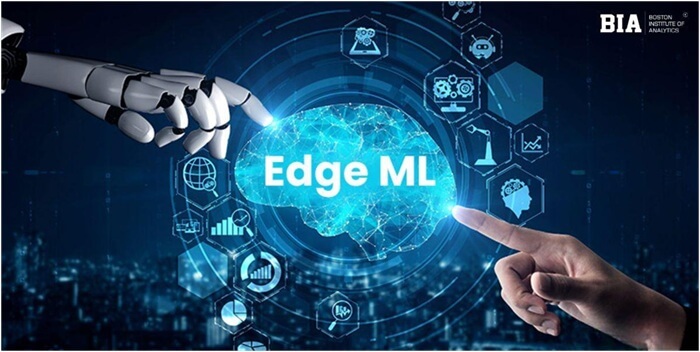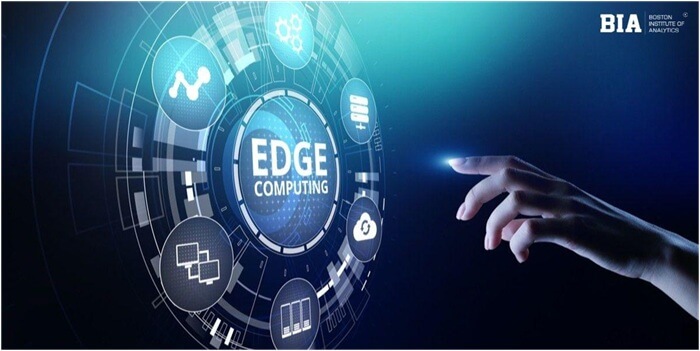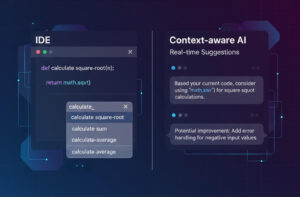The planet is producing data like never before. A huge amount of information is non-stop created through our mobile phones and wearable devices along with factory-based sensors and self-driving cars. In the past, most of this data would have been moved to the cloud for processing, analyzing, and deploying machine learning (ML) models.
But there is a shift from cloud computing to edge computing that brings the inference of machine learning and data processing right at the source, i.e. the devices. This transition is believed to open a new era of intelligent devices, lower response times, better security, and much less need for the centralized cloud infrastructure. Explore how Machine Learning in Edge Computing is reducing cloud dependency and powering smarter devices. Learn these cutting-edge skills with a comprehensive Machine Learning course designed for real-world applications.

The Rise of Edge Computing
Edge computing was well known long before it gained importance as a result of the Internet of Things (IoT) craze. Picture a smart city where the traffic is constantly monitored by cameras, air quality is being monitored by environmental sensors, and self-driving shuttles are going around the city. Transmitting all this unprocessed data to a remote cloud server for immediate analysis would add considerable delay, require a lot of bandwidth, and upraise major privacy issues.
Edge computing overcomes these issues by placing processing power at the “edge” of the network which are smart cameras, industrial gateways, or even mobile phones. Instead of the edge devices just collecting data and sending it to the cloud, they are getting more and more capable of performing local data processing. This dispersed strategy reduces the duration of gaining insights and acting accordingly greatly, which in turn, makes the systems more responsive and efficient.
Read More: No Car, No Problem: Technology Has Made Traveling Easier Than Ever
The Synergy: Machine Learning at the Edge
The real power of edge calculating is unleashed when united with machine learning. ML models, conventionally trained in powerful cloud settings, can now be arranged and run directly on edge devices. This addition creates “smarter” campaigns that can make intelligent conclusions autonomously, without constant announcement with a central server.
Consider a few compelling examples:
- Smart Cameras: Instead of transmitting every single frame to the cloud for object detection, a machine learning model working on an edge camera can mark anomalies or certain objects (for instance, a package that is left at a door) and only send alerts or compressed data to the cloud that are relevant. This leads to a significant decrease in bandwidth usage and an increase in the effectiveness of real-time security monitoring.
- Predictive Maintenance in Factories: Vibration or temperature data from industrial machines might be gathered by sensors. At the edge, a machine learning algorithm would process this information continuously to anticipate failure and send maintenance alerts before an expensive breakdown occurs. This eventually eliminates the need for downtime and increases the efficiency of operations.
- Autonomous Vehicles: The use of machine learning is extensive in self-driving cars for perception (recognizing their environment), planning (making the right actions), and control (carrying out movements). Due to the urgency for instant decision-making, it is beyond the realm of possibilities for these ML models to be completely located in the cloud. They have to be at the edge, on the vehicle.
- Healthcare Wearables: A fitness tracker can continuously check the heart rate of the user, the quality and duration of his/her sleep, and how active he/she is. A machine learning model that runs on the device can recognize heart rhythm irregularities or a sudden fall of the user and notify emergency services or the user’s relatives, all this without the transfer of sensitive medical information from the device unless it is really necessary.

Read More: The Rise of Smart Home Devices: How Technology Is Transforming Modern Living
The grouping of machine learning and edge computing offers a horde of advantages:
- Reduced Latency: Arguably, this is the most important advantage that comes along with it. If the data is processed at the local level, then the decision can be taken in no time at all. For applications like self-driving vehicles, hospitals, and factories, the low latency is not only a plus but also a prerequisite for safe and efficient operations.
- Lower Bandwidth Consumption: The cost of transmitting huge amounts of unprocessed data to the cloud is high and can lead to network congestion. With Edge ML, the devices cleverly use their processing power and send to the cloud only the very little data that has been gleaned and is of high importance, thus, cutting down the bandwidth usage and costs that come with it considerably.
- Enhanced Privacy and Security: Data that is sensitive and could be in the form of health information or surveillance footage when processed at the edge is not required to be transferred to a central cloud server thus, there is very little chance of a breach. This is an issue that poses a challenge for compliance with regulations such as GDPR and HIPAA.
- Improved Reliability: Sometimes the cloud is not accessible especially in places where the environment is difficult or far away. Edge devices with machine learning programmed in them can work continuously and even make smart decisions when there is no internet connection, thus guaranteeing operation without interruptions.
- Cost Efficiency: The requirement of less expensive cloud computing, storage, and processing has a considerable saving in the long run against the initial investment in more powerful edge hardware.
- Scalability: Edge computing gives rise to the distributed architecture that facilitates the IoT scaling in deployments without the central cloud system being overloaded.
Challenges and Considerations
While the reimbursements are compelling, positioning machine learning at the edge is not short of its challenges:
- Resource Constraints: Edge devices usually don’t have the same level of computational power, memory, and battery life as cloud servers. Consequently, the ML models need to be optimized very often by means of quantization, pruning, or knowledge distillation in order to be run smoothly under these constraints.
- Model Deployment and Management: The process of deploying, updating, and managing near to a thousand or even millions of machine learning models in a large but the different edge devices network can be hard. Strong MLOps (Machine Learning Operations) practices are a must.
- Data Labeling and Training: The process of inference is done at the edge, but the training phase of complex ML models is still very much dependent on the cloud’s huge computing power. Furthermore, the collecting and labelling of data sets that are diverse and specific to edge cases is still a huge barrier to overcome.
- Security of Edge Devices: The more intelligent and capable edge devices become, the more they are likely to be attacked. Thus, the issue of security for these scattered endpoints becomes priority number one.
- Hardware Diversity: The different range of edge hardware, which includes tiny microcontrollers and powerful embedded systems, indicate that the application of ML solutions must be done by making them more compatible with specific platforms.
Read More: Freedom Holding Corp: How Technology Shapes Their Financial Services
The Future is at the Edge
There is no question, we are seeing a trend of pushing intelligence closer to the data source. With advances in hardware capabilities and optimizations in machine learning frameworks for edge deployment, we can anticipate many creative applications. From smart homes that can actually predict our needs to performing industrial operations hyper efficiently and true autonomous systems, machine learning in edge computing sets the stage for a future in which devices are not simply connected, but are truly intelligent.
Final Thoughts
For both individuals and organizations seeking to reap the benefits of this revolution, a clear understanding of machine learning is no longer a “nice to have,” but fundamentally required. A complete machine learning course can give you the foundational knowledge and practical skills to produce intelligent models in the cloud or at the rapidly emerging edge. Knowing how to work with optimized models for resource-constrained environments will be particularly advantageous.
The continued movement towards some world rich with connected intelligent devices will benefit from the partnership of machine learning and edge computing as a key driver of smarter systems, reducing our reliance on centralized cloud architecture and ultimately will make our digital world more responsive, private, and efficient.







